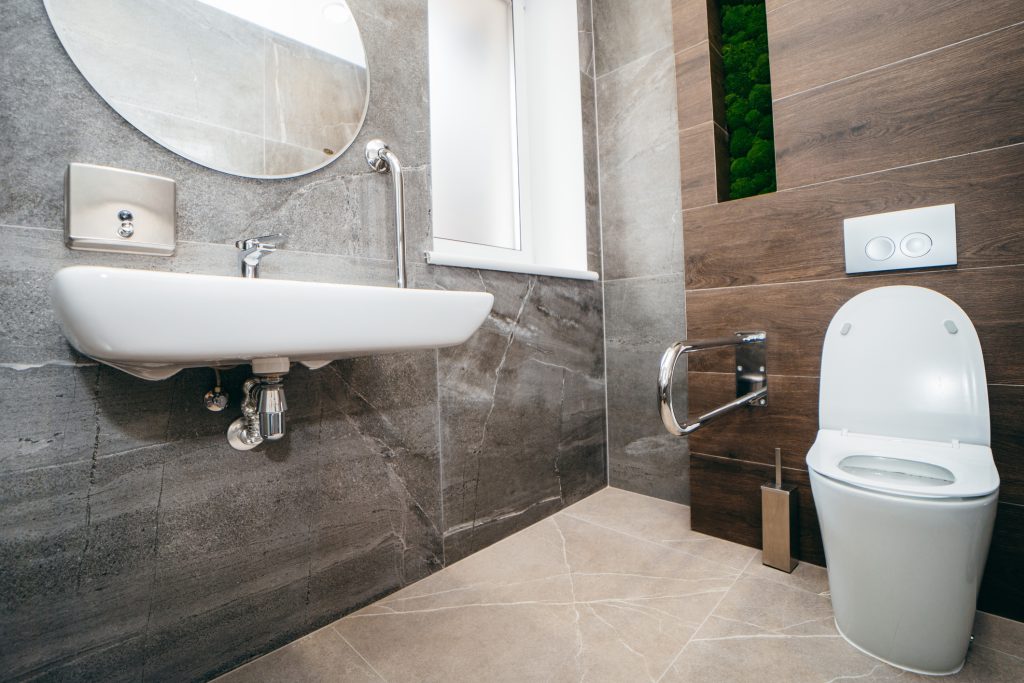When considering bathroom modifications for disabled individuals in Ottawa, it is essential to prioritize safety, accessibility, and comfort. A bathroom should not only be functional but also provide a sense of independence for its users. Adapting a bathroom for those with physical challenges involves strategic adjustments that enhance mobility, improve safety, and ensure that daily tasks can be performed with ease. These changes can drastically improve the quality of life for disabled individuals, offering them a space that is both safe and welcoming.

Non-Slip Flooring: The Foundation of Bathroom Safety
One of the most crucial elements in any bathroom remodel for disabled individuals is ensuring that the floor is slip-resistant. Bathrooms are notoriously hazardous, particularly when wet, and a fall can lead to severe injuries. Non-slip flooring offers essential protection and can help prevent accidents. There are various materials available that provide excellent traction, including rubber, textured vinyl, and slip-resistant tiles.
Rubber flooring is a popular choice for many because it provides cushioning in addition to its non-slip properties. For those looking for a more stylish yet practical option, textured vinyl is an excellent alternative. Not only does it resist slipping, but it is also easy to maintain, making it a versatile option for bathrooms. Another choice is slip-resistant tiles, which come in a wide range of colors and designs to match the bathroom’s aesthetic. However, it’s important to ensure that the grout lines on the tiles do not become slippery when wet, so textured tiles with deeper grooves are recommended.
Grab Bars: Essential for Stability and Independence
Grab bars are a simple yet effective modification that significantly enhances bathroom safety. These bars provide stability and support for individuals as they navigate through their daily bathroom routine. Installed next to toilets, showers, and bathtubs, grab bars allow individuals to safely lower themselves or rise from a seated position without risking a fall.
There are several types of grab bars available, including horizontal, vertical, and angled. Horizontal grab bars are typically installed near toilets, offering support when getting up and sitting down. Vertical grab bars, on the other hand, are ideal for showers and bathtubs, providing additional support for individuals as they move in and out of the space. Angled grab bars are excellent for helping individuals who may have limited mobility or struggle with bending. For a more discreet look, decorative grab bars are available in a variety of finishes and designs, allowing them to blend seamlessly with the bathroom’s style.
Walk-In Bathtubs: A Safe and Comfortable Alternative
For individuals with limited mobility, a traditional bathtub may pose a significant challenge. Entering and exiting a standard bathtub requires stepping over a high side, which can be dangerous for someone with mobility issues. Walk-in bathtubs solve this problem by allowing users to enter the tub through a low door, making it much easier to bathe without risking a fall.
Walk-in bathtubs are designed with a door that swings open, providing a wide opening for easy access. Many also come with built-in seating, which allows individuals to sit comfortably while bathing. Some models are equipped with hydrotherapy jets, offering added therapeutic benefits. The installation of a walk-in bathtub is an excellent investment for individuals seeking a safe and comfortable bathing experience.
Shower Seats: Adding Comfort and Accessibility to the Shower
For those who struggle to stand for long periods or have difficulty balancing, shower seats provide an essential solution. These seats allow individuals to sit while they shower, reducing the risk of fatigue and falls. Shower seats come in a variety of styles, from fold-down models that save space to portable chairs that can be moved in and out of the shower.
Wall-mounted shower seats are an ideal option for permanent installations, providing stability and support. These seats can be installed at an appropriate height for the user, ensuring comfort and ease of use. For individuals who may have specific mobility needs, adjustable or height-changing seats are available, providing even more customization.
Adjustable Mirrors: Enhancing Visibility and Comfort
An often-overlooked bathroom feature for disabled individuals is the mirror. Standard mirrors can be challenging to use for individuals who use a wheelchair or have limited mobility. Adjustable mirrors are an excellent solution, allowing users to tilt or raise the mirror to a height that is comfortable for them.
These mirrors are available in a variety of styles, including wall-mounted and countertop models. Many adjustable mirrors come with a swivel or extendable arm, making them easy to adjust without requiring physical strain. Additionally, some models feature magnifying mirrors, which are especially helpful for tasks like shaving or applying makeup.
Raised Toilet Seats: A Simple Yet Effective Modification
Another important modification to consider is the installation of raised toilet seats. For individuals with limited mobility or those recovering from surgery, a raised toilet seat can make it easier to sit and stand. By increasing the height of the toilet, these seats reduce the strain on the knees and back, making the process of using the toilet more comfortable and safer.
Raised toilet seats come in various sizes and styles, including those with built-in arms for extra support. These seats can be easily installed on most standard toilets and are an affordable option for improving bathroom accessibility.
Automatic Faucets and Controls: Reducing Physical Strain
Manual faucets can be difficult to operate for individuals with limited hand strength or dexterity. Automatic faucets, which are activated by motion sensors, eliminate the need to turn knobs, making it much easier to use the sink. These faucets not only improve accessibility but also help conserve water, making them an environmentally friendly option.
Similarly, automatic or touchless controls for showers and toilets can make using the bathroom even more effortless. Touchless technology reduces the need for physical interaction, ensuring that the bathroom can be used with minimal effort.
Wide Doorways and Barrier-Free Entry: Facilitating Easy Access
For individuals who use a wheelchair or mobility aids, wide doorways and barrier-free entry are essential. Narrow doors and thresholds can make it difficult to enter the bathroom, and in some cases, may prevent wheelchair users from accessing the space entirely. To ensure the bathroom is fully accessible, it is important to widen doorways and eliminate any obstacles, such as steps or thresholds, that may impede entry.
Wide doorways, typically 32 to 36 inches, are recommended for easy maneuverability. Additionally, eliminating any barriers at the entrance, such as raised thresholds or steps, creates a seamless transition into the bathroom.
Lighting and Visual Aids: Enhancing Safety and Comfort
Proper lighting is crucial for ensuring safety in the bathroom. Individuals with visual impairments may struggle to navigate poorly lit spaces, increasing the risk of accidents. Installing bright, energy-efficient lighting can improve visibility and reduce the likelihood of falls.
Task lighting, such as lights installed over the sink or shower, can help illuminate specific areas. Additionally, installing nightlights can provide subtle illumination during the night, helping individuals find their way to the bathroom without stumbling.
Smart Technology: A Modern Solution for Enhanced Accessibility
With the rise of smart home technology, there are now innovative solutions that can be incorporated into bathroom designs to further improve accessibility. Smart toilets, with features such as automatic flushing and heated seats, can provide comfort and convenience for individuals with disabilities.
Incorporating voice-activated devices allows users to control the lighting, temperature, or even the music in the bathroom without needing to physically interact with switches or knobs. These features are particularly beneficial for individuals who have limited mobility or those with physical impairments.
Why Choose Adaptive Living?
At Adaptive Living, we understand the importance of a safe and comfortable bathroom environment for disabled individuals. Our team specializes in designing and implementing bathroom modifications that not only meet safety standards but also promote independence and ease of use. Whether you’re considering non-slip floors, grab bars, or smart technology, we offer personalized solutions that cater to your specific needs.
Our experience in creating accessible living spaces has allowed us to develop a deep understanding of the challenges disabled individuals face daily. We are committed to delivering high-quality modifications that improve the quality of life and ensure safety. When you choose Adaptive Living, you are selecting a partner dedicated to enhancing the living experience of those with disabilities, one thoughtful modification at a time.



